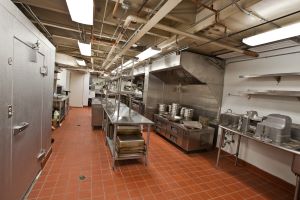Licensing Modernization - Update
Revisions to the MDA food licensing law were signed into law on May 23, 2025, and are in effect starting August 1, 2025. Changes are now in place for all new food businesses, and existing food businesses will be updated as they renew their licenses. More information about the process, including summary reports, are on MDA’s Food Licensing Modernization webpage.

Retail food is food, other than restaurant food, that is purchased to eat off the premises. This includes meats, produce, milk, bread, eggs, snacks, and many other items. In Minnesota, more than 8,000 licensed retail food establishments offer consumers an extensive amount of goods every day.
The Minnesota Department of Agriculture's (MDA) Retail Food Program conducts periodic inspections to assesses food safety plans, facilities, employee knowledge and performance to verify food establishments have the needed capacity to protect food and consumer health. Preventing illness caused by germs and other agents in food is the shared objective. Managing risk to health through sound food safety practices, sanitary facilities, and informed consumers is the most reliable way to reach that goal.
Each year a comprehensive look at the Retail Food Program's resources, budget, and accomplishments is compiled in an annual report. These reports can be found on the forms and resources section on the right of this page.
FAQ

According to Minnesota Statue, a retail food establishment is an operation that stores, prepares, packages, serves, vends, or otherwise provides food and beverages for human consumption. The food is sold directly to the consumer or indirectly through a delivery service. Most retail food establishments in Minnesota must have a Food Handler License to operate. Some examples of retail food establishments include, but are not limited to:
- Grocery stores
- Convenience stores
- Bakeries
- Meat Markets
- Mobile food units
- Wineries
- Taprooms
- Vending machines and micro markets
- Farmers' market stands

If you are applying for a Food Handler License, you must first complete an Applicant Form. Contact the MDA Licensing Liaison or your local food inspector to review your business plans and obtain the form. You will need the following information to submit the Applicant Form:
- Minnesota Tax ID number or social security number
- Legal business name (and DBA, if applicable)
- Physical address of your food business
- Majority of sales (direct to the end consumer or sales to other businesses who will re-sell or further process the food)
- Pre-Licensing Applicant Form fee ($50)
After applying, our MDA Technical Review Team will evaluate your business plan and connect you with your area inspector to schedule a licensing inspection. The Technical Review Team will request additional information about your business including:
- All planned food handling activities and specialized processes
- Need for a facility Plan Review
- Final signoffs from specific inspectors (i.e., plumbing, building, fire, electrical, etc.)
All retail food establishments and mobile food operations fall under the Food Handler License category and have the same licensing fee structure. License fees are based on your gross annual food sales and food safety risk. If you are found operating without a license, then a no-license penalty fee will apply.

Retail Food Inspectors work closely with the MDA Plan Review Team to review facility plans for remodeling or new construction. Once facility plans are approved, inspectors will conduct an onsite inspection and compare the submitted and approved plans to what they observe in the food establishment. The inspector will verify agreed upon revisions or corrections noted in the plan review approval letter, and ensure the food establishment layout, equipment and room finishes meet the Minnesota Food Code requirements. The inspector will license or approve the food establishment for operation if Minnesota Food Code requirements have been met, and the food establishment has received final approvals for trade work. Trade work includes electrical, plumbing, or building code requirements. More information on the plan review process can be found on the Plan Review - Retail Food Establishments page.
In addition to verifying the food establishment has met the requirements within the Food Code, the inspector will verify the new business owner/operator has basic food safety knowledge applicable to their operation. Estimated gross annual food sales and food safety risk will be used to be determine the license fee collected. Like any inspection, the food inspector will leave a report which outlines if the business is approved to operate or what steps are still necessary before approval is granted.
The Retail Food Program inspects licensed food establishments at set frequencies based on the highest risk food activity within the business. There are five potential categories for a food establishment to be designated, which can change as the business and menu change over time. Additional inspections can occur as necessary such as follow up inspections, complaint inspections, or emergency response inspections.
Risk Classification | Frequency | Types of Processing | Examples |
|---|---|---|---|
Type 1 | 9 months | Food facilities with specialized processes which require a HACCP plan | Meat Shops that smoke and cure foods, sushi kiosk with acidified rice |
Type 2 | 12 months | Food facilities with complex processes for a variety of foods which could involve cooking, cooling, reheating and hot holding | Large grocery stores with extensive deli preparation |
Type 3 | 18 months | Food facilities that prepare less complex food products such as heating and holding only | Convenience Stores |
Type 4 | 36 months | Food facilities with limited processing of foods or primarily only serving already prepared foods | Brewery taproom or small convenience stores |
Type 5 | 42 months | Food facilities that only hold shelf-stable pre-packaged foods or raw agricultural products | Gift shops with limited snacks offered |

Most routine inspections are unannounced to observe the activities and risks of the operation without advanced notice. Inspectors will notify the person in charge of their arrival, and show a government issued ID at the start of every inspection. During an inspection the inspector will:
- Ask open ended questions to the person in charge and their employees to learn about the menu, knowledge, health policy, and practices related to food safety.
- Observe food processing and cleaning operations within the food establishment focusing on food-borne illness risk factors.
- Educate the food workers on food safety practices and provide resources as necessary based on their observations.
- Work with the food establishment owners, managers, and employees to take immediate corrective actions during the inspection and help operators find long term solutions to prevent future violations.
- Leave a report at the end of the inspection which may include orders for violations observed during the inspection.
- As necessary, follow up on inspection findings during subsequent inspections.
The MDA Retail Food Program partners with various agencies including the Minnesota Department of Health, Minnesota Department of Public Safety, Minnesota Department of Labor and Industry, and others when necessary. Some food facilities are inspected by multiple inspection programs within the MDA such as the Manufactured Food Inspection Program, the Meat Inspection Program or the Dairy Inspection Program.
Minnesota Department of Health
Retail food establishments are licensed by different regulatory authorities in Minnesota based on the type and predominance of business. Predominance of business means that a majority (51 percent or more) of the gross annual food sales comes from that type of food or activity. If you want a license for an operation that is primary food service, such as a restaurant, you will need to obtain a license from the Minnesota Department of Health (MDH) or one of their delegated agencies. Go to the MDH Licensing Jurisdiction page for more information.
Delegated Agencies
The MDA Retail Food Program delegates its authority to license and inspect regulated retail food establishments to seven agencies within the state. This means that within these jurisdictions, the local agency is responsible for licensing, plan review, enforcement of the Minnesota Food Code, and other applicable regulations as it relates to retail food sales.
| Agency | Address | Phone |
|---|---|---|
| City of Bloomington | Environmental Health Division City of Bloomington 1800 West Old Shakopee Road Bloomington, MN 55431 | 952-563-8934 |
| City of Brooklyn Park | Code of Enforcement and Public Health Division 5200 85th Avenue North Brooklyn Park, MN 55443 | 763-493-8070 |
| Hennepin County (except the cities of Crystal, Edina, Golden Valley, Hopkins, Richfield, St. Louis Park, and Wayzata | Epidemiology and Environmental Health 479 Prairie Center Drive Eden Prairie, MN 55344 | 612-543-5200 |
| City of Minneapolis | Minneapolis Environmental Health Public Service Center 250 South Fourth Street Room 414 Minneapolis, MN 55414 | 612-673-2301 |
| City of Minnetonka | City of Minnetonka Health Division 14600 Minnetonka Boulevard Minnetonka, MN 55345 | 952-939-8200 |
| Ramsey County (except the cities of Maplewood, New Brighton, and City of St. Paul) | Environmental Health Section St. Paul-Ramsey County Department of Public Health 2785 White Bear Avenue, Suite 350 Maplewood, MN 55109 | 651-266-2400 |
| City of Saint Cloud | Health Inspections Department 400 Second Street South St. Cloud, MN 56301 | 320-255-7214 |

